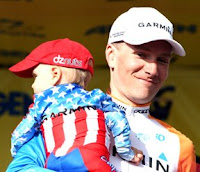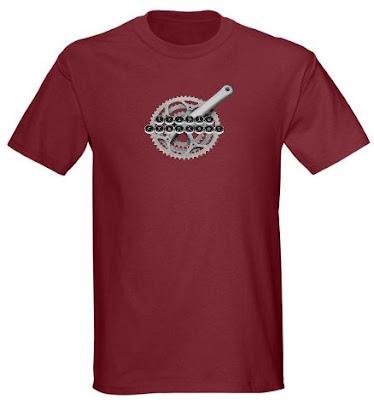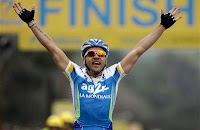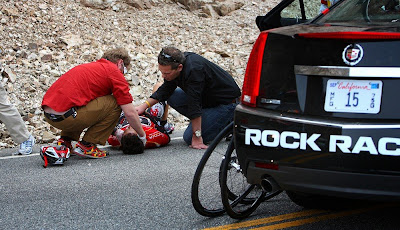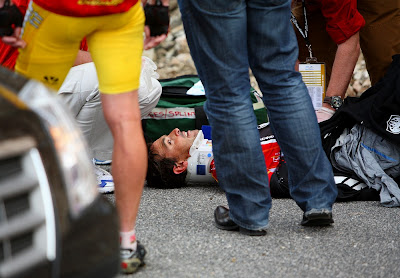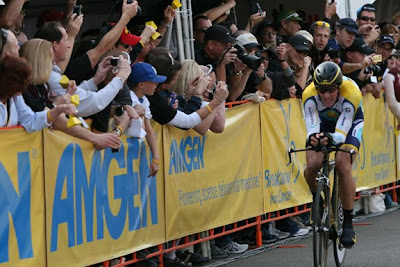
As the news broke of 18-year-old Taylor Phinney’s remarkable victories last weekend, setting a new American records and winning gold in both the individual 4 kilometer pursuit and in the 1 kilometer time trial, at cycling's Track World Cup Finals in Copenhagen, you couldn’t help but feel that the future of American cycling is indeed bright.
But, for every
Taylor Phinney there are countless numbers of American children who are lost to other sports every year.
The bicycle is an integral part of childhood, as fundamental as the scraping of knees or getting in trouble, but few American children are ever exposed to the sport of cycling at their most impressionable time.
Enter
JETCycling.
The Southern California based junior development program was founded by
Jet Tanner, whose vision is to grow the sport of cycling in North America so that it may one day rival the numbers and opportunities of other youth club sports.
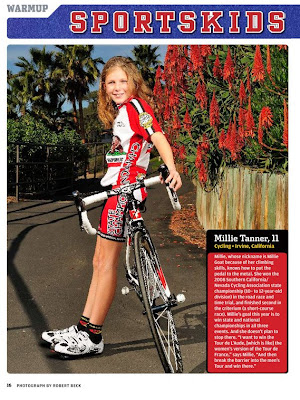
Recently, I had the unique opportunity to speak with a few of the JETCycling juniors, including Jet’s 11-year-old daughter,
Millie “Milliegoat” Tanner, who recently graced the pages of the February issue of Sports Illustrated Kids, 15-year-old
Jordan Hirschmann, 16-year-old
Scott Stern, and 17-year-old
Anthony Felix, as well as JETCycling’s Vice President of Athletic Development,
Dotsie Bausch, and Jet Tanner to find out more about the junior development program and to get their perspectives on the sport of cycling.
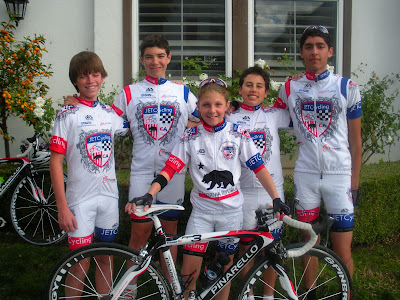
As you'll soon discover, the challenges on the bike are similar for those starting out in the sport no matter what age, cycling should not preclude one from being a good person and a good student, not all junior programs are created equal, and maturity sometimes belies age.
What are some of the challenges working with Juniors?Dotsie: It’s challenging because the kids are all working on different things and each has specific goals. One has the goal of racing Junior Nationals, but one of the requirements is that he needs to be a [Cat] 3 before he can race at Nationals, so he’s go to get through the 4’s by the time Junior Nationals rolls around. They all have different goals, and so dramatically different.
Each age is so different. From Millie’s 11 to Scott’s 15, it’s night and day as far as their development and what they’re ready for, what challenges they’re ready for, the miles, all of it. So we have to piece it together because if they all just trained the same together all of the time, Millie would just be in a hurt locker all of the time, 24/7, while the other kids might not be getting worked out. So you definitely have to massage it and do different things for different ones.
Its fun and they really seem to enjoy each other. It’s a good mix of kids and Jet really enforces that their grades and school come first; practice is second. We’re really trying to move junior cycling forward to the point of if they like it and stick with it, maybe going to a college with a good cycling team and possibly get recruited on that aspect as well as their academics…just getting them to be well-rounded, but with academics as their number one.
I don’t know if any junior programs out there are like that, maybe, but I don’t think so.
I’ve been at some events where the juniors are just thrown into a big field because they don’t have enough participants. What are the specific categories?Dotsie: There are specific ages, 11-12, 13-14, 15-16, and 17-18. Locally, they just changed the women’s this year from 11-14, so it’s something that Millie is clearly freaking out about because she has to race against 14 year-olds. And I would be to. It’s a big jump from 11 to 14. The gaps are bigger than if you’re 25 racing against a 28 year-old; there’s really no difference there in the development.
But that’s a little unfortunate, but the guys will stay separate because there are enough of them. Scott went to the line a couple of times last year, he’s 15 1/2 now, and there were 50 in the field.
It’s about drawing kids in. One of our athletes came over from triathlon, and already had a love for riding her bike. A few of the kids, like Jordan, didn’t come from any other sports, but came in and really fell into it, took to it, and has some good talent. It’s about bring kids into the sport. You know what athletics does for kids and their confidence and their mind and their progress in the world and in society as they grow up. So it’s about bringing people into cycling, a sport that’s not very popular or stressed in high school.
It’s about moving the sport forward and bringing awareness to the sport, even if it means circulating thousands of flyers about JETCycling. There are so many cyclists in the area and a great many of them have kids, but they aren’t aware of junior programs like ours because not many outlets publicize it. Hopefully interviews like this can get the word out so that people know what’s out there and where to go and be part of the camaraderie.
It’s tough for kids, and even for me as a woman, to be riding with grown men all the time in group rides. It certainly is a different level, which is good, but it can also be debilitating to the spirit if you’re not ready for it. It can be a bummer when there are always people that are faster and always wanting to go hard, so to have kids your own age, and the camaraderie, and training and racing together with a team.
Have you incorporated any track work into the program? What is your experience out on the track?Jet: Our program is focused on the road, but we do try to get them out to the track 2-3 times a year for the experience.
Dotsie: I would like to, but it’s a matter of time management. School comes first and on a good day the Home Depot Center is 45 to 50 minutes away. I’m hoping that we can get them out there during the summer when school is out and they have more time.
It would be so great for the kids and their bike handling skills and their tactile function to get out on the track. But we are primarily focused on road racing.
 Anthony: (left)
Anthony: (left) I have some experience on the track and it’s really fun and awesome. The steep angle is like riding up wall.
Scott: I have to say that I like road racing because I like sprinting, but I’ve gotten better at climbing and I think this year I’ll really love road racing and sprinting at the end.
Jordan: I’ve been to the track a couple of times and I like the track a lot. I would have to say I like road racing the best, knowing when it’s going to end, there are lots of people there, and you get to draft off of people. I don’t like time trialing so much.
Millie: I’ve been to the track and it didn’t work out so well. I kind of fell. But my favorite is the road race and the time trial because one of them is long distance and the other is all effort.
Do any of you have any cycling role models?Dotsie: Not so much in cycling, no…not really. The obvious people have done great things, but the people I look up to most are the ones that have affected me personally rather than those that can go fast. Some of those fast people really aren’t that nice. They are usually off on their own and into their own deal; not really something to look up to. So I think it’s the people that I’ve been teammates with that have really inspired me daily, like
Tina [Pic] who I have been teammates with for four years. I’ve always looked up to
Sue Palmer-Komar…it’s the people that I’ve been teammates with and raced with not someone like an Eddy Merckx. I think he was just an amazing cyclist, but I never knew him. I’ve never been inspired by just pure athletic endeavors…you know it’s like you have talent and work hard and you can pull some races out, but it’s what you do with that, how you give that back to the world and that’s what matters more. Those girls are still racing,
Iona [Wynter-Parks], the people who you’ve been in the trenches with who never give up and never give up on you.
Anthony: I would have to say…my dad. There are plenty of pros who people idolize but I would have to say my dad. He brought me to the sport and he’s my hero.
 Scott:
Scott: (left) One of the most important people in cycling who has taught me everything is Jet. He usually spends the time with me unlike many pros. The pros, yeah they’re really good, but how many take the time to make you better.
Jordan: The biggest cycling role model would definitely have to be Jet. He’s taken me to the next level and taught me so much. Even though I’m not a very competitive person I still enjoy cycling.
If I had to pick a pro, it would be
Giddeon Massie. He’s just classy and talks with great care. Some would be like, “I just want to get rid of these kids.” Also, Dotsie, she has just taught me so much and when we’re out training she’s given me tips. They’re both amazing.
Millie: Dotsie Bausch is such a huge person who’s affected me and my cycling. She just given so much to the sport, and said, “yes we can do this we’re able to do this”…the same with
Amber Neben. They were both able to come and ride with us and talk with us and say, “Ok, you’re having a little trouble how maybe we help.”
Michael Engleman, who has helped Women’s Cycling by founding the USWCDP, is also a strong influence in my cycling.
Scott: Both Anthony and I also think that the most important pro in our cycling career right now is Dotsie.
Jet: I know they don’t need to say that about Dotsie, but if you saw her out there really putting in the effort, taking and seizing the moment. To seize the opportunity to be with kids is, to me, very powerful. What she does for us as our Athletic Director, I can’t thank her enough. She’s such an influence.
Do any of you have parents or family members who are into cycling?Anthony: My dad has been riding bikes for a really long time. He’s the person who really got me into it and found the JETCycling program for me. I can’t thank him enough for that because I think JETCycling is really going to help me as a person and keep me on the right track.
Scott: No one in my family rides. I used to row, and got injured and the only training I could do was riding. I found Jet, and he found me, and hopefully he can help me to college and to the pros.
Jordan: I got into cycling because of my brother, and he got into it because of my uncle. I thought it was pretty fun and I wanted to get to the next level. I never really wanted to race. But when I went to Jet, he showed me racing and I really enjoyed it.
How long have you been involved with the program, and how long have you been racing?Millie: I’ve been racing for 3 years now. As far as my experience, I was a state champion in California for time trialing and road racing and I just like to have fun out there.
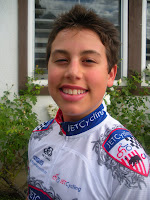 Jordan:
Jordan: (left) I’ve been with JETCycling for 1 year. I started out mountain biking but never raced. It’s been a pretty good experience and its taught me a lot.
Shawn: I’m in the 15-16 and I’ve been racing for 6 to 8 months and been with JETCycling for as long. I started in the middle of last year, which was really tough. But I got better as the season went on and I’m hoping for a strong season.
Anthony: I race 17-18. I just started with JETCycling about a month ago. I started out mountain biking and then switched to road. It’s a really great program and I hope it takes me somewhere in the future. I’m looking to make progress and be better.
What’s your favorite part about cycling?Anthony: Going fast and meeting new people. It’s just a fun sport in general. I think everyone could benefit from it.
Scott: Going fast and making new friends in the pack and the team camaraderie. During the race you really relying on each other, no one’s in charge. And I really like my sponsors.
Jordan: I really like being outdoors. I especially like the feeling after a ride. You just feel so good, so healthy. It’s a healthy sport, and with JETCycling you can ride with a lot of kids your own age and make some connection. I really like our sponsors, Team Duke because we get to learn about cancer and the USWCDP when they come down and mentor us. They give us encouragement and tips.
Millie: Being an ambassador. The sport is fun and going up to someone and saying, “Hey, I just did this cool thing. Why don’t you come out and try it.” I also like the wind in my hair and flying down hills now that I’ve gotten used to the speed.
What has been the most difficult thing to pick up in road cycling?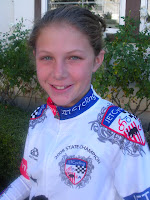 Millie:
Millie: (left) One of the hardest things to adapt to was cornering so fast. There’s always the thought of what if there’s a tiny rock around the corner that I’m going to hit and going to fall. One of the hardest things to get used to is going around the corner fast and knowing that you’ll stay up and make it through…in riding with a pack and by yourself.
Scott: I think the hardest thing racing 15-16 was that there were 40 guys within 2 centimeters from each other and being able to go around the turns right off someone else. My first race I was lapped five times.
Jet: Learning to adjust to the speeds is definitely one of the most difficult things. When they’re first exposed to it they’re not sure quite what to expect. I try not set too high expectations because of the pace, which is definitely a lot different than what they’re used to from training rides. Going out there for the first time creates some uncertainty and because it is so fast paced being able to maneuver, getting boxed in or moving up in the pack becomes interesting. From a coaching perspective, it’s a challenge to teach those types of things, but it also things like how to take a feed bag or motor pace behind a scooter or a car, or take off your jacket. I think it’s different for everybody.
Jordan: This past season the hardest thing was to keep up. My whole goal was to keep up. Some days I did, some I didn’t. So this year it’s about keeping up and having fun.
What are your goals for the 2009 season?Jet: I have pretty high expectations. I think every coach does when you look at your athletes that you’re training and working with on a day-to-day basis. My goals are pretty simple. From an overall perspective the number thing that they have to have is fun…enjoying the sport! There is a competitive nature to it, but whether you finish first or last that’s not the ultimate goal. To me, it’s whether you had fun and did you enjoy it. That’s the measure of success in cycling.
As a secondary goal, I look at cycling as a way for these kids to connect and hopefully be ambassadors of our sport so that we can grow it.
The main reason I started JETCycling, as you know, is to help these kids find a place to ride their bikes and learn how to be competitive in road cycling. They’ll also get that team feeling that sense of camaraderie.
We set both short term, medium range, and long term goals, and by the end of the season I hope to have a couple of state champions and national champions on hand! That would be awesome…over the top. If we were able to match what we did last year, 5 state championship wins as well as nine top ten finishes at nationals, it would be amazing.
Millie’s goal is 3-3-3. Third year racing, three state championship wins and three national championship wins. We hope to help her achieve her goals. She has the ability, now we have to put in the effort to achieve the success.
Jordan wants to be known as the spoiler. He wants to go out there and drive the pack, create chaos and help his teammates win. So my goal is to help him be fit enough to do those things.
Scott wants to win and be on the podium. My goal is to help him achieve that level, and he has a solid chance to do so.
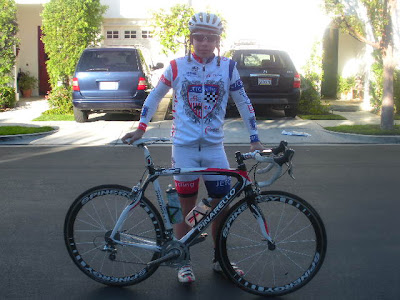
Anthony wants to do the same, and he has set some short term goals to be successful. We are trying to set the right expectations, and give him the assistance he needs to do well.
So helping each child reach their individual potential is a goal that is important to me because that’s where you see success. If a child says to me that he doesn’t care if he finishes last as long as he can help his teammate win, and I can help that child achieve that goal then we feel that success. We reach that goal together.
What is your biggest challenge for this season?Millie: My biggest challenge this year is the mental aspect. The body has it, the legs have it, the muscles have it, but do you believe in yourself…well that is the serious question. If you believe in yourself anything can happen. If you don’t believe in yourself you’re going to have a hard time trying to accomplish your goals, doing what you what to do. And in that split second when you believe in yourself, anything can happen.
Jordan: It’s definitely the mental aspect. It’s what Jet has been giving me a hard time, all the time, telling me that I’m the only one stopping me from doing what I want to do. I have to believe in what I am doing and why.
Scott: The hardest part is the mental aspect of not being intimidated by new competition. You don’t know who they are, they’re much bigger than you, but it doesn’t mean they’re faster.
Anthony: Since this is my first year, my biggest challenge is finding myself both mentally and physically.
What are your aspirations as a rider, do any of you envision going into the professional ranks?Jet: When you look at our program we have three avenues to success. One is we want to get our athletes to college on a collegiate cycling team, secondly we hope to get them on a national team, and finally we hope to help them get to the pros.
 Millie:
Millie: I want to go to college, and race. Bring my team to collegiate nationals and win that. And then hopefully get on a national team and do well there. And then I want to go pro’s and get to the Tour de France and break the barrier into the men’s field. After that if I’m not too old, I want to get on the Olympic team and win the Olympics.
Jordan: My main goal…I don’t have a big interest in being a pro. I want to do other things and I definitely will take cycling with me for the rest of my life, but I don’t have a desire to go to college on cycling, it would be nice. But I don’t really want to be a pro.
Scott: I definitely want go to college for cycling and win at the collegiate level and hopefully get on a national team and race in Europe for a bit and then go pro and race for one of the top UCI teams.
Anthony: Basically I look at cycling as something else to get to college. When I get to college, if I go pro or have the opportunity that would be great, but I’m just looking at cycling as a way to get to college.
Jet: I think it’s common to all athletes, when you’re a kid and in cycling you dream and want to become a pro. What’s unique about our group is that they want to go to college and have that experience in college first before they make that leap. It’s like we’re a farm system that gets juniors in the right direction first. That way it gives them the skills to fall back on when cycling is not abailable.
How should the sport of cycling handle riders who used performance enhancements?Dotsie: That’s perhaps an hour long conversation. I get out of competition testing so they are at my door whenever they feel like it and I have to show where I am every minute of every day. As a clean athlete you have to feel confident that they seem on top of it, but I don’t know. Too many athletes and girls that I’ve been on teams with before have come up positive just from taking approved supplements. Truthfully, the whole thing is frightening and a big mess.
I think a lot of the professional men are ahead of the curve with some of the stuff they’ve come up with. So I think the testers need to get ahead of the curve especially in the European peloton. I know in the women’s peloton it doesn’t run nearly as rampant.
The truth is I really don’t think about it as often. I’m clean and don’t have any desire to do it any other way. You can spend a whole lot of brain power and energy just thinking about it and it just doesn’t get you anywhere. The dopers are going to dope and the other aren’t. That’s just sport since the beginning of time. So what should they do to them…you’d like to say kick them out of the sport forever, but what about those athletes who have said that their supplements were tainted. If they are telling the truth then they shouldn’t be kicked out for one day. So you can’t have a no tolerance policy. What I wish was that they had foolproof tests. But we’re all fallible, we’re all human, labs can make a mistake. In a perfect world, I wish that weren’t the case because its not fair when an athlete has to serve even one day, of say a six month ban, when they didn’t do anything. I don’t think there is a single answer, but rather an ongoing process and conversation.
You’re not ever going to be able to stop the cheaters…that are just in their fiber, it’s what they’ve chosen to do, it’s the kind of people they are. There is no USADA, WADA or any other governing body that is going to stop every one. It’s how do we manage it so that is more fair is the question, because you’re not going to stop doping.
Jet: We all hope that everyone is racing clean. We’re trying to do everything we can to create a change in our sport, to change the perception of cyclist as dopers. I kind of look at it from a different standpoint in that I believe we should remove “doping” from our cycling vocabulary. We should call it “cheating” or “not playing by the rules” or “using performance enhancements,” but “doping” puts such a negative light on our sport and those who do it. As a word, it puts our sport in a negative light and gives juniors the vision of needles and drug addicts. The wrong impression! It is just one word.
Yes, there are some athletes that cheat and use performance enhancements to change their body makeup, but in no way, shape, or form do I support that. My goal here is to take that word out of the sport because we get equated with those who use heroin or other recreational drug and it’s not what our athletes in our sport are doing. Well, I at least hope not.
What have you learned from being a part of JETCycling?Anthony: I learned things about cycling and about bikes, but also learned how to be a better person in general. That there a lot more things out there than just riding my bike. Riding my bike is fun, but there are lots more things that can help me be a better person.
 Scott:
Scott: The thing I’ve learned from JETCycling is to be humble and no matter what you do and to do your best. If you put the effort in, eat right, train right, you’ll definitely get rewarded.
Jordan: One of the big things I’ve learned at JETCycling is to really think about others and not just yourself and to be respectful and to just appreciate life. I work at a children’s hospital and when I look at others I’m just appreciative that I’m healthy and can ride my bike. [Jordan works at Children’s Hospital of Orange County. He works with children who are very sick. Along with his two dogs, a Great Dane and a St. Bernard, he spends time with the children or tries to cheer them up]
Millie: Patience. Just wait and it will happen. You have to do the right things. You have to eat right, you have to train right and get a certain amount of sleep. You just can’t go and play video games all night. You have to do all things to get where you want to be. You gonna have to get your hands dirty before anything happens.
What’s the most important thing that you’ve learned about working with juniors?Dotsie: Personally, they have continually given more to me than I feel like I have given to them from the aspect of the energy and excitement they have about the sport. Once you are in something for a long time and have been in it for a while things get stale. They just keep me so pumped every time I ride with them. If I go to their practice and I’m in a grumpy mood from whatever went on that day, I’ll arrive home chipper. They are so invigorating; they are so happy and stoked to be on their bikes. Practice is always positive and we are always in hysterics the whole time. We are always laughing about something.
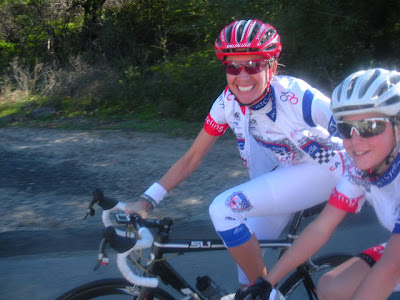
It’s fun to watch them develop. Recovery is a tough thing to teach them. It was hard at the end of last season to try and get them back down and relax and rest and not sprint for the sign or sprint to the top of every single hill like it was a KOM. It’s invigorating for me and fun to teach them all the parts of cycling that make it come full circle and make it successful. I’ve really learned that the recovery is one of the key aspects that are really difficult for them to grasp…and to make that a habit. Because it takes them about 10 minutes to recover for the next day [laughs]; their recovery is incredible, but it doesn’t stay that way. So it’s been good to share that with them. They definitely have given back more than I give to them.
Jet: The one thing that I like about his sport is that the age groups that we’re dealing with are really varied. We deal with athletes from 8 to 18 years of age, and each one is different. What’s interesting to me is looking at the makeup and the growth experience that they have. It’s not so much watching it, but coaching and learning how to coach each individual, and immediately watch them learn. I like watching them be successful and attain their goals and reach for the stars, and be good people. That’s where I draw the most satisfaction from and that’s where I learn the most as well. Each one of these children is an individual and they’re try to learn a sport, but it’s also about how can I help each to be a good person and do right by the community, and have a sense of community, team, and maintain their individuality at the same time. All are challenging things, and a lot of work, but I feel very, very grateful that I have an opportunity to do that.
If you could impart one bit of wisdom to your riders, what would it be?Dotsie: Give Back.
Any closing comments?Millie: We need more juniors in sports. No matter what your age or ability we need more kids to get out there. We just need more kids out there. Right now it’s small, but if we can get one person, can change it, and it can be huge. That’s what we need.
Scott: I just wanted to thank Jet and Dotsie again.
Jordan: I don’t think any of this would be possible without Jet. We basically started from nothing to where he has built it up to where we have sponsors. It would be impossible with JETCycling and all the sponsors that have supported us in the support way, or in the financial way. It’s really great that they support us.
In some areas of California and I don’t know where else, but a lot of kids go to school and then go home and sit on the couch and get fat. I know a lot of kids my age, around 14, and their parents aren’t home to tell them what’s right and they get into drugs. Biking is a good distraction from drugs, and not just drugs but bad things. A lot of kids are under a lot of pressure from society both academically and responsibility wise. Cycling is a great way to stay out of trouble and to get a good start on life.
Anthony: The sport is great. We need more juniors riding bikes. I think it’s important that we keep continue to do this whether it is for college, for health reasons, or just for the fun of it. I think it would be great for the cycling community.
 Jet:
Jet: We rings true to me is that we need to get more kids involved and more children out there. I know I’ve mentioned in the past, of growing this like and AYSO, or a Little League, or Pop Warner football league. If we could get more of these JETCycling groups popping up everywhere and being able to give the kids the opportunity to get on a bike. Did you know there are more kids on bikes than there are playing football, baseball, soccer, combined? If we get them out there racing and competing then that would be awesome.
On a final note we have some sponsors that have really stepped up to the plate with us. To me I couldn’t have done it without them. They have invested in JETCycling because of the outlook of having juniors get into this sport. Companies like
A Road Bike 4 U, Gita Bikes,
Giro,
Northwave,
Pactimo,
Pinarello, Skins,
Speedplay, hudz, Schwalbe,
Kurt Kinetics,
Sports Performance Institute, inhouseIT,
Swiftwick,
Vanderkitten,
Hammer Nutrition and
Smith Optics; these companies just believe in what we’re doing in helping grow this sport! They’ve invested in us, and we in turn, invest in them by helping them from a marketing perspective. We want to be able to pass their products, or information on to more kids or parents of children who are interested. Create a partnership and a team for success.
To follow that up we work with two non-profit organizations the John Wayne Cancer Foundation,
Team Duke, to help raise awareness for skin cancer. We teamed up with them and they help us out financially to buy bikes. I really didn’t’ understand what their company was all about until they told me that skin cancer is created within the first sixteen years of a person’s life and that means as a child being out in the sun being exposed to the sun ends up as an adult turning into skin cancer…so what a perfect group to be working with us because our kids do presentations at schools to pass along that information. To me, that’s a way of us helping them. But also with the
USWCDP, and Dotsie comes from that program to help mature our kids and support the team. Plus, Vanderkitten has stepped up to the plate to help us with our junior women and offer apparel for them. It’s huge, and that’s because of their belief in wanting to give back to the sport. I think it’s apropos when you asked Dotsie if there is one word of wisdom you could offer, she said “give back.” A lot of this sport is about that, giving back to the sponsors, giving back to the community, giving back to the people, and giving back to kids. That’s what our sponsors are doing for us and now we’re going to do it for them.
Photos: Courtesy JETCycling

 In the shorter women's verion of the race, 128km to the 203km covered by the men, 24-year-old Suzanne de Goede (Equipe Nürnberger Versicherung) of the Netherlands claimed her second Omloop Het Nieuwsblad title, having won her first in 2006 as a member of AA Drink. Noemi Cantele (Bigla) took second and Kelly Druyts (Topsport Vlaanderen-Thompson) rounded out the podium.
In the shorter women's verion of the race, 128km to the 203km covered by the men, 24-year-old Suzanne de Goede (Equipe Nürnberger Versicherung) of the Netherlands claimed her second Omloop Het Nieuwsblad title, having won her first in 2006 as a member of AA Drink. Noemi Cantele (Bigla) took second and Kelly Druyts (Topsport Vlaanderen-Thompson) rounded out the podium.

